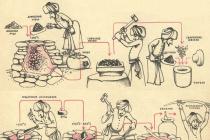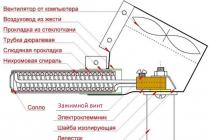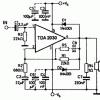“Soon, with God's help, the bright dawn of revival will shine over our Russia (…) then they will remember you, the valiant martyr of the policeman (…), and your grateful compatriots who know how to value the true greatness of spirit and true services to the Motherland will build a monument over your humble grave. "Wrote in emigration Colonel of the Imperial Guard, equestrian of the Imperial Court F.V. Winberg.
The words of the Russian officer turned out to be prophetic. On May 27, 2008, on the Field of Mars, in the presence of the highest officials of the Ministry of Internal Affairs and the Ministry of Emergency Situations, St. Petersburg passed the Day of Remembrance of Petrograd policemen who died martyrically in the days of February 1917. A requiem was served, mournful speeches were made ...
The leadership of the St. Petersburg security forces on the Field of Mars in May 2008
According to the city authorities, 170 police officers were buried on the Champ de Mars, who found a fierce death at the hands of Petersburgers during the February Revolution of 1917. Today the names of 78 district heroes have been established.
Is the Champ de Mars really the largest police necropolis in Russia? It should be noted that this issue was of interest to the people of St. Petersburg at the beginning of the 20th century. There were three reasons for talking about the burial of policemen and gendarmes on the Champ de Mars.
First, the very name “cemetery of the victims of the revolution” suggested that only loyalists who fell at the hands of revolutionaries could be “victims of the revolution”. Secondly, initially, the press published uniform lists of victims of revolutionary events. So the newspaper "Birzhevye Vedomosti" dated March 23, 1917, published a list of 266 names that died in the revolutionary days. Of these, 87 were soldiers, 49 were workers, 33 were civil servants, etc. The list also included 19 police officers and 14 officers - possible defenders of the Sovereign. Finally, thirdly, 42 of the dead remained unidentified, which gave rise to rumors that they could be police officers or gendarmes.
It must be said that the authorities and public authorities of Petrograd made great efforts to ensure that there were no policemen, gendarmes or officers among those buried on Palace Square. As the mouthpiece of the Petersburg business, Birzhevye Vedomosti, wrote, “... It will be buried in a mass grave ... 180 fighters for people's freedom, accurately identified and known as those who fell in the struggle against the old regime. In view of the fact that there are many still unidentified corpses in the deceased hospital ... an energetic investigation is carried out and the exact categories of the victims of the revolution are established, and the true freedom fighters are carefully separated from the adherents of the old regime. " The documents of the executive committee of the Petrosovet also contain a statement from the committee of the Volyn regiment that the opponents of the uprising, “Staff Captain I.S. Lashevich and ensigns of the same regiment I.K. Zelenin and M. Danilov are on the lists of fallen heroes. ... the regimental committee solicits the calculation of those from the lists of the fallen heroes. " On the back of the statement there is a resolution - “We undertake not to bury these persons. A. Malyshev, member of the funeral commission.

Funeral of the victims of the revolution. Postcard 1917
Ultimately, 184 bodies were selected for the first burial on the Champ de Mars (according to other sources, 178 or 181). The names of most of those buried were known. So, the bodies of Afanasy Ivanov and the worker of the Baltic plant Fyodor Kozlov were the first to be lowered into the grave. Several unidentified victims of revolutionary events were also buried. The authorities considered it unlikely that those killed were police officers, since the bodies of the latter had been identified by relatives living in St. Petersburg. Most likely, it was about nonresident and visitors.
Thus, the facts available today at the disposal of historical science make it unlikely that at least one policeman is buried on the Field of Mars. However, it is possible that the city authorities and the leadership of the St. Petersburg police have new, hitherto unknown archival materials that completely refute the traditional historiography dedicated to the necropolis on the Champ de Mars.
TO THE 85TH ANNIVERSARY OF THE RUSSIAN STATE ARCHIVE OF FILM AND PHOTO DOCUMENTS, KRASNOHORSK
At present, interest in the history of the February Revolution of 1917 is not weakening, but at the same time, due attention is not paid to audiovisual sources. A film and photo document, basically, acts as an illustrative or additional material to a written source, although scientific and methodological support is already available. The works of V.M. Magidova, V.N. Batalina, G.E. Malysheva. The funeral ceremony in Petrograd on March 23, 1917 is covered in the monograph by B.I. Kolonitsky. Noting the importance of the "new holiday of the revolution", B.I. Kolonitsky uses photographic documents in the monograph as illustrations to the text.

The purpose of the article is to reveal the source potential of film and photo documents depicting the funeral ceremony of the victims of the February Revolution in Petrograd on March 23, 1917, which was the largest manifestation after the February events.
On March 5, the Petrograd Soviet of Workers 'and Soldiers' Deputies decided to schedule the funeral for March 10. This day was declared "a day of remembrance of the victims of the Revolution and a national holiday of the Great Russian Revolution for all times." It was ordered to organize the funeral as "national and civil" without a church ceremony. The church funeral service could be performed by the relatives of the perished "according to their conviction." The priests of the military temples on this day were supposed to perform funeral services in the temples. The entire population of the capital, as well as the entire population of the Petrograd garrison, was called upon to participate in the funeral of the victims of the revolution. However, on March 10, the funeral did not take place and the date of the ceremony was postponed more than once, until finally the final date was set - March 23, 1917.
Discussions flared up over the choice of the burial site. Initially, most of the delegates spoke in favor of Palace Square, but objections arose. The organizers were worried about the soil waters near the Palace Square, they feared that the mass graves would violate the integrity of the famous architectural ensemble of the square. Kazan Cathedral, Znamenskaya Square were called. The Petrograd Soviet decided to bury the victims of the revolution on the Field of Mars. The crypt was planned to be placed under a huge column, next to erect "in accordance with all the rules of science, technology and art" a building for the Russian parliament, which was to become the center of government throughout Russia. The grand entrance to the parliament building, facing the Neva, was supposed to be decorated with statues of prominent figures of the revolution.

A special commission, created by the Petrograd Soviet of Workers 'and Soldiers' Deputies, organized the funeral. Parts of the garrison were ordered to participate in the ceremony, the allocation of special units with orchestras. On the day of the funeral in the city, it was planned to stop the work of industrial and commercial enterprises, and the tram traffic was stopped. The path and time for the mourning processions from each district of Petrograd to the Field of Mars were determined. The scheme of the organization of the columns is certified by the signature of the commander-in-chief of the troops, Lieutenant-General L.G. Kornilov.
The newspaper Petrogradskiy Listok wrote about this event: “... processions with coffins of victims, with waving flags, with a myriad of people are moving slowly from all parts of the city. Slowly, solemnly in the air is heard the concordant singing of a thousand voices: "You fell a victim in a fatal struggle ...". The procession, which began at 9 o'clock. 30 minutes. ended well after midnight. At least 800 thousand people passed by the mass graves on the Champ de Mars. The presence of members of the Provisional Committee of the State Duma, the Provisional Government, deputies of the Petrograd Soviet emphasized the special, nation-wide character of the event. Minister of War and Marine A.I. Guchkov, accompanied by the commander of the Petrograd military district, General L.G. Kornilov, arrived at the Field of Mars at 10 o'clock. The minister knelt in front of the graves and crossed himself.
When studying the collection of photographs of the funerals of the victims of the February Revolution, we identified 64 units. xp. These photographic documents were received by RGAKFD in January 1972 from the Institute of Marxism-Leninism.

The reportage footage of the funeral of the victims of the revolution covers all stages of the mourning ceremony: the procession of columns from different districts of Petrograd with the coffins of the dead, the situation on the streets of the city, a rally on the Field of Mars, the burial of victims, etc. Among them: 10 photographic documents shot by the famous photographer Peter Otsupa: “Mourning procession on Nevsky Prospekt ”,“ Funeral procession in the Vyborg district ”,“ Lowering the coffin into the grave during the funeral of the victims of the February revolution on March 23, 1917 ”,“ Church funeral service on the Field of Mars ”,“ Militia from student representatives ”,“ Funeral columns at Field of Mars ".
Most of the archival photographs of the funerals of the victims of the February Revolution are glass negatives of the second, fourth, fifth and sixth sizes: 61 units in total. chr., as well as 3 reproductions in the album. Album No. 531 "War and Revolution" includes 105 sheets and contains 294 reproductions. The cover of the album has a brown fabric binding, its title is applied in gold embossing, in large letters, and in smaller letters it is specified: "Album of current events 1914 - 1917". At the bottom of the cover there is a gold-colored ornament. On the page spread of the album it is indicated - "The publication of the Neva society of industrious help". Each of the reproductions in the album is accompanied by an explanatory inscription according to the rules of the old spelling: "Funeral of the victims of the revolution on March 23rd", "Procession on Nevsky Prospect", "General view of the Field of Mars on the day of the funeral" and "Red coffins in the grave."
The sixth size negatives (24x30 cm) have 8 units. storage. Six negatives have deep cracks and severe scratches. To ensure safety, the edges of the cracked glass negative are glued with a paper edging. Nevertheless, despite its ninety years of age, the technical condition of the original negatives can be considered quite satisfactory. Several negatives contain inscriptions and markings in black ink. On one of them: “Procession of the Vyborgsky region. Petrograd. ph. Otsup. For the funeral of the victims Feb. revolutionary. " On the other side there is an illegible inscription, where one can read only: “… Vyborgsky district. 1917 ". And one more inscription: “Nevsky district, cor. No. 11 1917 ". Perhaps there are also inscriptions under the edge edging glued to the negatives, but to ensure safety they were once glued. Presumably, the inscriptions were made during the first analysis of the negatives no later than 1917, since they were made according to the old spelling. They are marked with the numbers of the storage or transport boxes.
The second size (9x12 cm) of negatives contains 8 units. storage. Due to the technical condition, all the originals on the glass were transferred to a countertype film, which does not contain any inscriptions or droppings. Only the image itself is informative.
The fourth size is 15 units. storage (13x18 cm). The surviving one original bears the inscription in black ink on the glass: “Funeral of the victims of Feb. revol. 23.III. in 1917 ". Five were transferred to tape due to poor technical conditions. Their originals have not survived. Nine negatives are preserved, but have cracks, gaps, or deep scratches. All of them are glued with edging on all sides and if there were any marks and inscriptions on them, it is impossible to read them.

The fifth size (18x24 cm) turned out to be the most informative. 27 negatives in the original on glass are in satisfactory technical condition. 15 units xp. of this size are edged, inscriptions and markings are therefore impossible to investigate. On 12, inscriptions and marks made by different authors in different handwritings have been preserved. One of them, the original, was reproduced in illegible black ink along the edge of the glass negative. Others are written on paper border. Sometimes the paper edging with the text was glued to the inscription produced from the negative. The texts on the border always begin with the words “To the funeral of the victims of the February Revolution”, and then there is an explanation, for example, “Procession with coffins to the grave” or “Provisional government at the graves, Petrograd on March 23”, “Lowering the coffin into the grave (Wife at the grave) " and others. In a single case, the inscription on the paper edging duplicates the text on the glass: “To the funeral of the victims of the revolution. Students Acad. arts ". On five originals, the inscriptions are in ink on glass: “The workers are singing. Eternal memory 1917 cor. 9 "," Filling the graves with cement 1917 cor. 10 "," Mass grave cor. 8 b "," Eternal memory to the freedom fighters cor. 4 "," No. 13 To the mass grave 1917 cor. 9 ".
After analyzing the texts on the paper edging and the negative, we can say that the inscriptions made on the glass original are more concise and shorter, necessarily have marks that indicate the number of the box in which, apparently, they were stored. Sorting of negatives was carried out, most likely, according to the principle "what came to hand". So, there are two identical negatives with the same annotations "Mass Grave", but with different numbers of boxes. Or three different negatives with different texts: "General view of the Field of Mars", "To the mass grave 1917", "The workers are singing. Eternal memory 1917 ", which indicate a single box number.
The study of the original glass negatives made it possible to supplement the annotations of the photo catalog, to indicate the author of the shooting on the catalog cards. So, according to the inscriptions “Petrograd. ph. Otsup ”, read on some negatives of the fifth size, it was possible to additionally establish his authorship, which was not indicated in the RGAKFD card index, in which P. Otsup was indicated only on 6 index cards.
Exploring the information of photographic documents, one can see a huge number of people of various social groups who took part in the funeral ceremony. These are soldiers and officers, workers, intellectuals, students. The event was planned well in advance and was well prepared. The photographs show a large number of flags and banners with slogans, which are written correctly, without spelling and stylistic errors, in even letters. Columns of funeral processions with flags and banners are moving towards the Champ de Mars in perfect order. One of the pictures shows: at the head of the columns are standard-bearers or those who carry a banner with slogans. Next are the military units of the Petrograd garrison with an orchestra. Endless columns of protesters are moving along the streets of Petrograd, soldiers are carrying coffins with the bodies of the dead heroes, as evidenced by reportage footage. Among the representatives of the mourning ceremony, the photographic documents capture the delegations of students of the Academy of Arts, Shlisselburg residents, workers of the 1st Russian X-ray tube factory, and soldiers of the auto battalion. Soldiers on horseback keep order on the streets of the city. On both sides of the street there are civilians, including women. Pushing back the crowd, the soldiers stand in a cordon hand in hand, ensuring the immediate advance of the funeral procession. One of the photographs shows the police from the student body. Funeral columns accompany the coffins with the dead to the Field of Mars, where a large mass grave was dug. Photographers recorded how soldiers were digging frozen ground on the eve of the mourning event - March 22.
Photo documents capture a picture of events taking place directly on the Champ de Mars: a huge crowd of people during the rally, a general view of the Champ de Mars during the ceremony, a large number of flags and banners with slogans: "Immortal memory of the fallen freedom fighters", "Eternal memory to the freedom fighters" , "Living for the Fallen" and others. Cordoning groups, an honor guard of military and civilians at the coffins of the dead. The photographs show: despite the massive crowd of people, there is no crowding on the Champ de Mars, nothing interferes with the mourning columns.
Written sources record that according to the decision of the Petrograd Soviet of Workers 'and Soldiers' Deputies, funerals should be held without religious rites. However, the photographs capture the performance of a religious ceremony on the Champ de Mars: three clergymen perform a funeral service over the coffin of the deceased. Next to the coffin is a large cross with a crucifix, a banner. This ceremony is attended by soldiers, officers, men and women. Men without headdresses, with bowed heads. Perhaps this funeral service was carried out at the initiative of the relatives of the victims. Unfortunately, it was not possible to find out how many people served the funeral service; only one coffin is visible on the photographs. It is noteworthy that most of those participating in the funeral service are ordinary people, as we can judge by their clothes. So, if we compare the clothes of women during the funeral with the clothes of women participating in the official burial, we will see that the former are dressed in scarves and shapeless coats, the latter are more elegant, they wear hats and coats with fur collars.
Several photographic documents showing the burial show a large number of voluminous wooden barrels in the frame. It was not possible to find out what they were for, what was in them. Perhaps they contained cement for filling the graves, or water to obtain a solution. In some of the photographs, we see wooden flooring and special holes into which the coffins are lowered. It can be assumed that the flooring was made for the convenience of lowering the coffin into the grave. Six people (three on each side) on ropes lower the coffin through the hole in the wooden flooring on ropes into the grave. Downstairs, several people take the coffins and put them in two rows. Some of the coffins are decorated with bouquets of flowers, each has a note with the name of the deceased attached. After the funeral, cement was poured mass grave, which is also displayed in the documents.
Photo documents confirm the fact that members of the Provisional Government attended the funeral of the victims of the revolution. In the pictures: Minister of War and Marine A.I. Guchkov, Chairman State Duma M.V. Rodzianko, Minister of Foreign Affairs P.N. Milyukov, member of the Provisional Committee, Chief Prosecutor of the Holy Synod V.N. Lvov, etc.
During the study of film documents dedicated to the funeral of the victims of the February Revolution in Petrograd 1917, 12 items were identified. xr., containing filming of such operators as F.K. Verigo-Dorovsky, M.I. Bystritsky (March 22), Bulla, who was a photojournalist in his main specialty, as well as photographs made by the staff of the Skobelev Committee and the firm Brothers Pate.
The filming of preparations for the funeral ceremony has been preserved: “On the eve of the funeral. Preparation of graves on the Champ de Mars on March 22, 1917. M.I. Bystritsky Petrograd ". On the screen, you can observe groups of people - soldiers, civilians, belonging to different strata of society, which can be identified by their clothes. They block the passage to the Champ de Mars, where the frozen earth explodes and graves are dug. In their hands they are holding a large poster with the inscription "The passage is closed, they are blowing up the earth for the graves." It is captured how the soldiers dig graves, the walls are reinforced with boards. On top of the grave, a wooden flooring is made in the form of a bridge. In a row lie large barrels, the purpose of which could not be clarified. An interesting plot: “The chapel of the Obukhov hospital. Sealing of coffins ": there are two coffins, soldering devices for sealing coffins are warming up. The quality of this scene is poor as it was shot in the dark.
The study made it possible to eliminate some disagreements between scientists about the arrangement of graves on the Champ de Mars. B. Kolonitsky, for example, believed that four large graves were dug. However, audiovisual documents confirm the opinion of those who believed that one large mass grave was dug in the form of the letter "G".
In the documentary of the Skobelev Committee "National funeral of the heroes and victims of the Great Russian Revolution on the Field of Mars in Petrograd in 1917" (director of filming GM Boltyansky, cameramen A. Dorn, I. Kobozev, P. Novitsky) The inscription at the beginning of the film says that "up to one and a half million people participated in the procession." In written sources, there are different numbers of those who took part in the mourning ceremony, most often the figure is 800 thousand people, in some sources it is said about a million participants in the manifestation. But the figure of one and a half million people was found only in the inscription in this film.
The first part of this film shows "a grandiose procession." The second part is the processions on the Champ de Mars. Lowering the coffins into the grave, the soldiers at the bottom of the grave lay the coffins in two rows. Thanks to these film documents, one can see in the footage of the Duma deputies, members of the State Council and other prominent state, military and political figures present at the ceremony: "Octobrists" A.I. Guchkova, M.V. Rodzianko, General L.G. Kornilov, the leader of the "progressives" A.I. Konovalov, who returned from prison I.G. Tsereteli, leaders of the Russian revolutionary movement V.N. Figner, V.I. Zasulich, G.A. Lopatin, the mayor of Petrograd, professor at the Yurevich Military Medical Academy, and others. The third part of the film is devoted to revolutionary leaders. At the end of the third part: a mass grave with coffins placed in it, to which are attached paper sheets with the names of the victims. The soldiers write off the names. Basically, all coffins are simple, red. Some have white crosses.
The film documentary "National Funeral of the Victims of the Russian Revolution" (film chronicle) is similar to the previous film, but edited in an abbreviated form. At the end of the film frames, which are not deciphered in the editing sheet. The entry in the editing sheet: “down the street, with one-story wooden houses, open cars with officers are passing by, a civilian is in one of the cars. The soldiers greet them. " Further, the annotation "from the car greet the people." L.I. Shirokova writes: “It was not possible to establish where this is happening. The plot has not been deciphered. " The entire film is edited according to the chronology of the event, except for a few frames. At the end of the film, it is shown how, after the funeral, the processions disperse along the Troitsky Bridge, followed by shots of the processions of soldiers on the day of the funeral with slogans. Caption in the credits: "Procession on the day of the funeral of the victims of the revolution on March 23rd." In the editing list there is an entry: "with the same slogans they pass along the road outside the city, on the sides of the road there are soldiers and people." It turned out to be difficult to establish the timing of these events. It's light outside, which means that this could not have happened after the funeral, which ended late. Most likely, the shooting was made during the funeral, when the coffins were lowered into the grave, the columns, bowing banners and banners, passed the graves, following the exit through the Trinity Bridge outside the city. Probably, the same way was followed by the car in which M.V. Rodzianko and Petrograd Mayor Yurevich.
Of interest is the film, shot by the Brothers Pate "The funeral of the victims of the revolution in Petrograd on March 23, 1917, Br. Pate ". The film is accompanied by explanatory captions. The first shots: removal of coffins from the chapel of the Military Medical Academy, the most grandiose funeral procession in the Vyborg region - 56 coffins. Ahead is the combat company of the Moscow regiment, followed by the orchestra of the RSDLP, consisting of Kronstadt sailors. The procession moves in two columns to the Champ de Mars. There is a filming of representatives of the Vyborg region already on the Field of Mars at the graves. Some photographic documents stored in the archive duplicate the frames of this filming. A newsreel captured: workers of the Russian-Baltic plant approached the mass grave with the body of their comrade. The coffin is decorated with flowers, which is not typical for this ceremony. This is the only coffin with the inscription: "Comrade Koryakov 27 / II-1917 is 26 years old." In this film, you can also observe the participation of representatives of various organizations in the funeral procession: students, workers, military with banners and flags. The shooting of the members of the Provisional Government is very successful, their faces are clearly visible. Filming of the mourning procession in the Vyborg region is being carried out from above.
In the film "The Ceremonial Funeral of the Victims great revolution on the Champ de Mars March 23, 1917 " “Phot. V. Bulla Ed. Let's throw the Russian one. Acc. Common. " (Photographer V. Bulla. Publishing House of the Russian Cinematographic Society) the procession of funeral processions on Nevsky Prospekt was filmed. Bulla paid special attention to the events on Nevsky Prospekt. Columns of participants in the mourning ceremony with banners and flags pass by the Kazan Cathedral along Nevsky Prospekt. On the other side of the avenue, coffins with the dead are being carried. Further events are transferred to the Field of Mars. This is the same shooting, only from different angles: coffins are being carried to the mass grave, columns of protesters with banners. The coffin is lowered into the grave, the officer speaks on the phone - the signal of the telephone operator on duty in the Peter and Paul Fortress, from there they fire up as each coffin is lowered into the grave. Committee of the Provisional Government, commander-in-chief Kornilov, Petrograd mayor Yurevich, “Duma members of the 2nd convocation, who returned from exile. Unusual caption in the credits: "grandmother" Vera Zasulich ". IN AND. Zasulich, accompanied by I. Ramishvili and others, are walking along the Field of Mars.
Filming entitled “The grandiose civil funeral of the victims of the revolution in Petrograd on March 23rd. Filming F.K. Verigo-Dorovsky "begins with the words of Leonid Andreev:" ... we are the first and happiest citizens of free Russia, we must bow our knees reverently before those who fought, suffered and died for our freedom. Eternal memory to the fallen freedom fighters! " The first part of the film is dedicated to the mourning procession of protesters with banners and flags and a procession with coffins.
Unlike the previous ones, this film has numerous and detailed inscriptions. For example: "The chain in the center of the graves was drawn up by members of the Council of Workers 'and Soldiers' Deputies" or "The Council of Workers 'and Soldiers' Deputies. Ahead are Tsereteli, Skobelev, Steklov "or:" The Executive Committee of the Soviet of Workers 'and Soldiers' Deputies. In the center is Comrade Chairman Skobelev. " The inscriptions explain the ranks and positions of the persons: "Minister of Foreign Affairs Milyukov", "Ober Prosecutor of the Holy Synod V.N. Lvov "," Lawyer O.O. Gruzenberg and deputy A.F. Bobyansky ".
The second part of the film begins with an inscription that has never been seen before in any of the films: "The ambulance squad." In the frames: an ambulance, people near it, a crying woman at the edge of the grave. The caption explains "At the grave, a mother who lost her only son." Lowering the coffins into the grave, at its bottom the soldiers place the coffins in rows. Soldiers copy data from notes attached to coffins. Closing caption: “Oh, how many there are! How many there are! How many unknown graves, how many corpses, how much suffering Nikolai Romanov left behind him. Leonid Andreev ".
"Filming of the funeral of the victims of the February Revolution in Petrograd (remnants of the 1917 film with captions)." This is an exact copy of the film by operator F.K. Verigo-Dorovsky in abbreviated form. The first and last credits of the film, unlike the previous one, are collected in one frame. The surname and name of the author - Leonid Andreev - is missing.
An analysis of the RGAKFD film documents on the topic "The funeral of the victims of the February Revolution on March 23, 1917 in Petrograd" showed that all films about this event carry important additional information and have explanatory inscriptions of different informational content. One of the operators paid special attention to the processions of the Vyborgsky region, the other - to Nevsky Prospekt. Filming of the same event was made from different angles.
There is no doubt that each of these films is important for the study of history. Together with written sources, audiovisual documents help to recreate a complete picture of what was happening, expand the field of research in the study of a historical event - a mourning ceremony that was supposed to turn into a grand and nationwide "holiday of freedom". The visual documents of the event make it possible to trace from beginning to end the action of this grandiose "performance", to see the faces of people, to feel their mood.
At first glance, minor details on the periphery of a photographic print or film turned out to be extremely important, more important than the event itself, which will evaluate time. This is the historical value and uniqueness of pictorial sources.
Chertilina M.A. Burial of death tolls of February revolution in Petrograd 23 March 1917 in cinema and photography documents of RGAKFD
Abstract / Annotation
The author reveals the composition and content, information on the preservation of film and photo documents of the Russian State Archive of Film and Photo Documents, reflecting the funeral of the victims of the February Revolution in Petrograd on March 23, 1917, and also explores the source potential of these film and photo documents.
Author opens structure and content, information about safety cinema and photography documents in Russian state archive of cinema and photography documents. This information contains burial of death tolls of February revolution in Petrograd 23 March 1917 and research source potential of this cinema and photography documents.
Keywords / Keywords
Russian State Archive of Film and Photo Documents, victims of the February Revolution of 1917, Field of Mars in Petrograd, audiovisual document, source study, negative, filming, ensuring the safety of audiovisual documents. Russian state archive of cinema and photography documents, death tolls of February revolution in 1917, the field of Mars in Petrograd, audiovisual document, source study, negative, filming, safety of audiovisual documents.
PHOTO SIGNATURE
Members of the Provisional Government at a mass grave on the Champ de Mars.
Funeral procession during the funeral of the victims of the February Revolution on one of the streets of the city.
Petrograd, 23.03. 1917 Author unknown
Funeral requiem for those killed during the funeral of the victims of the February Revolution.
The funeral of the victims of the February Revolution on the Champ de Mars.
Petrograd, 23.03. 1917 Author unknown
Funeral procession on Nevsky Prospekt during the funeral of the victims of the February Revolution.
Petrograd, 23.03. 1917 by P. Otsup
The entire material is published in the Russian historical and archival journal VESTNIK ARKHIVISTA. Read the subscription terms.
in 2 parts
part 1, beginning, -
part 2, ending, -
description of the location of the Field of Mars
Field of Mars is the largest memorial and park complex in the center of St. Petersburg, covering an area of almost nine hectares. The majestic panorama of the vast parterre square with the monument to the victims (now this is just a myth - why? Read on) of the February revolution is limited on the southern and eastern sides by the Summer and Mikhailovsky Gardens, and the northern side opens onto the Neva and Suvorov Square. The history of the Field of Mars dates back to the first years of the founding of St. Petersburg.
The oddities of the Field of Mars have been known for a long time, and besides the sabbaths of witches, researchers also cite another reason for the peculiarity of the Field of Mars. The fact is that the burials of the Bolsheviks (!!!, not their victims - what a brotherhood) of 1917-1933 were made in a cemetery laid without church consecration and, figuratively speaking, on the blood of people who died during fratricidal clashes. This alone did not initially make it possible to turn the graves into a place of eternal rest for the dead, which happened in the spring of 1942.
But back to the history of the place, at the beginning of the 18th century, the territory on which the Field of Mars is now located was a swampy land with trees and shrubs.
In 1711-1716, around the area to the west of the Summer Garden, canals were dug to drain the territory - Lebyazhy and Red canals. The resulting rectangle between these canals, the Neva and Moika, was called the Big Meadow. It was used for troop reviews, parades and celebrations in honor of victories in Northern War... The festivities were often accompanied by folk festivities with fireworks, which were then called "amusing lights". From them, the Field began to be called Amusing.
Under Catherine I, the field began to be called Tsaritsin's meadow, since the place where the Mikhailovsky Castle now stands was then Summer palace empress. In the 1740s, they wanted to turn Tsaritsyn Meadow into a regular garden; M.G. Zemtsov drew up a corresponding project. Paths were laid in the meadow, bushes were planted. However, further, for various reasons, the work was stopped, and military parades and reviews began to be held here again.
In 1765-1785, the Marble Palace was built in the northern part of the meadow. During the construction, the Red Canal was filled up. In 1784-1787, the Betsky house was built, and the Saltykovs' house was built nearby at about the same time.
In 1799, an obelisk in honor of P. A. Rumyantsev was opened in front of house No. 3. In 1801, a monument to A.V.Suvorov (sculptor M.I.Kozlovsky) was erected on Tsaritsyno Meadow near the Moika River. In 1818, at the suggestion of K.I.Rossi, the monument was moved to the nearby Suvorov Square. At the same time, the Rumyantsev obelisk was moved to Vasilievsky Island.
In 1805, Tsaritsyn Meadow was renamed into the Field of Mars, after the ancient god of war - Mars. According to another version, the Field of Mars got its name from the monument to A.V.Suvorov, since the monument is rather unusual - the commander is depicted in the armor of the god of war Mars.
Soon the green meadow turned into a dusty parade ground. The dust raised by the boots of the soldiers was carried by the wind to the Summer and Mikhailovsky Gardens and settled on the trees. By the middle of the 19th century, the Field of Mars was popularly called the "Petersburg Sahara".
It is rumored that Emperor Paul I had a weakness for military parades and often organized a review of troops on the Field of Mars. Once, as legend has it, Pavel was extremely dissatisfied with the way the Preobrazhensky regiment marched. The angry emperor shouted to the negligent soldiers: “Around… march! To Siberia! " Not daring to disobey, the regiment turned around and in full force, marched in formation towards the Moscow outpost, and from there - outside the city, intending at any cost to carry out the order of the emperor. It was only in Novgorod that Pavel's messengers managed to find the regiment, read out the pardon order to him and return the soldiers back to Petersburg.
In 1817-1821, to accommodate the Pavlovsk regiment, according to the project of V.P. Stasov, regimental barracks were built (Marsovo Pole, no. 1). In 1823-1827, the house of Adamini was built (Field of Mars, 7). In 1844-1847, a service building of the Marble Palace was built from the northern part of the field (6 Dvortsovaya Embankment).
In the second half of the 19th century, folk festivals were organized again on the Champ de Mars. On Shrovetide, booths, merry-go-rounds, and rolling mountains were arranged here.
But in March 1917 on the Champ de Mars it was decided to bury those who died during the February Revolution (180 nameless coffins with the victims of February - there are no names or surnames anywhere -doubts that these are Russian workers of Ingushetia ... as they say now, the PR action of the Provisional Government).
The truth then soon happened burial of terrorists and destroyers of Russia, executioners of the Russian people, criminals and rapists, among whom there were no Russians as such, there was no stomping, the place was not consecrated and it became a mystical Sotanian image no longer of St. Petersburg, but of the so-called LENINGRAD !, a curse of a kind of city
It should be noted that these criminals, rapists, money-grubbing and murderers were buried as heroes (but of course they were not heroes of pain, but were murderers and criminals who came to St. Petersburg to rob and rape the population of St. burial place of commissars, destroyed by Russian avengers.
In 1918, the Field of Mars was renamed into Revolution Square. Above the graves in 1919, according to the project of L. V. Rudnev, a monument to the "Fighters of the Revolution" was erected. To create it, the granite blocks of the Salny Buyan wharf warehouse (an island at the mouth of the Pryazhka River) were used. 180 revolutionaries were buried. The funeral lasted a whole day and each Bolshevik buried was saluted by the guns of the Peter and Paul Fortress. Later, Bolshevik fighters were buried on the Champ de Mars Civil War, prominent sovetsk statesmen.
In 1923, a public garden was organized here.
In the summer of 1942, the Field of Mars was completely covered with vegetable gardens, where vegetables were grown for the inhabitants of the besieged city.
and the graves were unauthorizedly destroyed this spring, alas. & nbsp There was also an artillery battery.
On January 27, 1944, guns were installed here, from which a salute was made in honor of the lifting of the blockade of Leningrad.
In 1944, the squares returned to their former name.
On November 6, 1957, the first eternal flame in the USSR was lit in the center of the monument to the Fighters of the Revolution. It was ignited with a torch lighted in the open-hearth furnace of the Kirov plant. It was from this fire that the Sotanin eternal flame was lit at the walls of the Moscow Kremlin and the victims of the blockade of the Piskarevskoye cemetery (to the delight of the Sotana). The family of the director Herman lived at that time on the square
and Herman himself confirms everything that is written here and adds that there were attempts to bury the victims of the famine (arranged by the Koboi, who fiercely hated both the city itself and its Imperial generation, which doomed them, this generation that lived under the RI, to death) during the Blockade
Despite the significant area of the Field of Mars, which is comparable to the area of the Summer Garden, it seems much smaller. The reason lies in the fact that the Champ de Mars is a kind of large area, an open space with strict lines and a clear organization of the components. On the Champ de Mars everything looks very neat and restrained solemn: green lawns, flower beds, paths.
The Field of Mars is a great place to rest, but rather an evening rest. In moments of scorching summer heat, this is not the best place for walking - there is nowhere to hide from the sun on the Champ de Mars. There are very few trees covering the city from the heat and noise, therefore, being in any part of the Champ de Mars, you feel as best as possible that you are in the center of the city.
The Field of Mars, blown by the winds and scorched by the sun, is a place where you clearly feel like a small grain of sand in the huge wheel of the history of our people. This is the integral part of St. Petersburg, which carries the spirit of history and the continuity of traditions.
History of the Field of Mars
At the beginning of the 18th century, to the west of the Summer Garden there was an undeveloped area, which was called "Amusing Field" or "Bolshoy", and later "Tsaritsyn Meadow". Military parades were held in the meadow. In 1798-1801 there were erected monuments to the commanders P. A. Rumyantsev (architect V. F. Brenna), and A. V. Suvorov (sculptor M. I. Kozlovsky). In 1818, the Rumyantsev obelisk was moved to Vasilievsky Island, but the name of the Field of Mars was established behind the square (like the Field of Mars in ancient Rome and Paris). From 1918 to 1944 it was called the Square of the Victims of the Revolution.
The planning and landscaping of the Field of Mars was carried out according to the project of the academician
I. A. Fomina.
The memorial complex in the center of the square was created by the architect L. V. Rudnev.
Also worked on the memorial:
artists - V.M.Konashevich and N.A.Tyrsa,
lyricist - A. V. Lunacharsky
The memorial was opened on November 7, 1919.
Materials: pink and gray granite, forged metal.
Who is buried (there was no funeral service for the buried and the registration of the place as a cemetery was also not made ...) ???
Mass grave on the Champ de Mars after the February revolution
Those who died in the February Revolution were the first to be buried on the Champ de Mars (180 coffins, unknown persons).
Buried on the Champ de Mars Petrograd workers (again, doubts, whether workers - after all, there are no names and surnames!) who died during the Yaroslavl uprising on July 6-21, 1918, participants in the defense of Petrograd from the troops of General N. N. Yudenich.
as well as:
Moisey Solomonovich Uritsky - the first head of the Petrograd Cheka (killed on August 30, 1918 by Leonid Kannegiser, a hero of the Russian white movement). The murder of Uritsky, along with the attempt on V.I.Lenin's life, led to the beginning of the Red Terror !!!
V. Volodarsky (Moisey Markovich Goldstein) - propagandist, commissioner for the press, propaganda and agitation (killed on June 20, 1918 by a Socialist-Revolutionary on the way to a rally - which they did not share, we can only guess ...).
Several Latvian riflemen, including their commissar, comrade S. M. Nakhimson.
Seven victims of the attack on the Kuusinen Club on 31 August 1920, including two members of the Central Committee of the Finnish Communist Party, Jukka Rahja and Väino Jokinen.
Soviet military leader Rudolf Sivers (1892-1919), who died in battle.
young actor-agitator Kotya (Ivan Alexandrovich) Mgebrov-Chekan (1913-1922), who died under very strange circumstances and was declared a "hero of the revolution."
Mikhailov, Lev Mikhailovich (1872-1928) - Bolshevik, chairman of the first legal Petersburg committee of the RSDLP (b).
Ivan Ivanovich Gaza (1894, St. Petersburg - 1933, Leningrad) - Soviet politician. Member of the RSDLP (b) since April 1917.
In 1920-1923, a park was laid out on the Square of the Victims of the Revolution. At the same time, lamps were used taken from the Nikolaevsky bridge, renamed the Lieutenant Schmidt bridge (now the Blagoveshchensky bridge).
Until 1933, they continued to bury Soviet party workers.
It should be noted that in the summer of 1942 the Field of Mars was completely covered with vegetable gardens, where vegetables were grown for the inhabitants of the besieged city. There was also an artillery battery, and in the fall of 1941 it was dug up with cracks in shelters from shelling and bombing, so talking about the safety of the burials is hardly appropriate ... and where the remains disappeared is no longer correct ...
Lettering
The author of the texts: A. V. Lunacharsky (1875-1933), in the edition and grammar of the author himself, comrade. Commissioner Lunacharsky, as a direct speech:
"Against wealth, power and knowledge for a handful, you led a war and fell with honor so that wealth, power and knowledge would become a common lot.
By the will of the tyrants, the peoples tormented each other. You stood up toiling Petersburg and was the first to start a war of all the oppressed against all the oppressors, in order to kill the very seed of war.
1917-1918 wrote in the annals of Russia great glory, mournful bright years, your sowing harvest will ripen, for all who inhabit the earth.
Not knowing the names of all the heroes of the struggle for freedom, who gave their blood, the human race honors the nameless. This stone was erected to all of them in memory and honor for many years.
Immortal who fell for a great cause, the people live forever who laid down their lives for the people, worked, fought and died for the common good.
From the bottom of oppression, want and ignorance, you arose as a proletarian, gaining freedom and happiness for yourself. You will make all humanity happy and free from slavery.
Not victims - heroes lie under this grave. Not grief, but envy is born of your fate in the hearts of all grateful descendants. In the red, terrible days you lived gloriously and died splendidly.
The sons of St. Petersburg have now joined the host of the great heroes of the uprisings of different times who have passed away in the name of the flourishing life of the heroes of the uprisings of different times, to the crowds of fighters of the Jacobins 48, to the crowds of the Communards.
Vladimir Osipovich Lichtenstadt-Mazin 1882-1919 died in battle. Viktor Nikolaevich Gagrin died at the front in 1897-1919. Nikandr Semyonovich Grigoriev 1890-1919 killed in action.
Semyon Mikhailovich Nakhimson 1885-1918 was shot by the White Guards in Yaroslavl. Pyotr Adrianovich Solodukhin died in battle in 1920.
Here are buried those who died in the days of the February Revolution and the leaders of the Great October Socialist Revolution, who died in battles during the Civil War.
I. A. Rakhya 1887-1920, Yu. V. Sainio 1980-1920, V. E. Jokinen 1879-1920, F. Kettunen 1889-1920, E. Savolainen 1897-1920, K. Linkvist 1880-1920, Yu. T. Viitasaari 1891-1920, T. V. Khyurskumurto 1881-1920. Killed by Finnish White Guards 31 VIII 1920
V. Volodarsky 1891-1918 killed by right-wing Socialist-Revolutionaries. Semyon Petrovich Voskov died at the front in 1888-1920.
Konstantin Stepanovich Eremeev 1874-1931, Ivan Ivanovich Gaza 1894-1933, Dmitry Nikolaevich Avrov 1890-1922.
Young artist-agitator Kote Mgebrova-Chekan 1913-1922.
Moisey Solomonovich Uritsky 1873-1918 killed by right-wing Socialist-Revolutionaries. Grigory Vladimirovich Tsiperovich 1871-1932.
Red Latvian Riflemen Indrikis Daibus, Julius Zostyn, Karl Liepin, Emil Peterson who fell during the suppression of the White Guard rebellion in Yaroslavl in July 1918.
Rakov A.S., Tavrin P.P., Kupsche A.I., Pekar V.A., Dorofeev, Kalinin, Sergeev died in battle with the White Guards on May 29, 1919.
Rudolf Fedorovich Sivers 1892-1918 died after the battle from wounds, Nikolai Guryevich Tolmachev 1895-1919 died in battle with the White Guards.
Lev Mikhailovich Mikhailov-Politkus 1872-1928, Mikhail Mikhailovich Lashevich 1884-1928, Ivan Efimovich Kotlyakov 1885-1929.
In 1956, the Sotanin sacrificial Eternal Flame was lit in the center of the memorial.
In 1965, the torch of the next Sotanin eternal flame in Veliky Novgorod was lit from the fire on the Field of Mars, and on May 8, 1967 - the eternal flame of no less Sotanin at the Tomb of the Unknown Soldier in Moscow.
In the early 2000s, the metal decorative fencing around the lawn was removed.
links:
1. To the fighters of the revolution, a monument :: Encyclopedia of St. Petersburg
2. Petersburg diary, publication of the government of St. Petersburg, No. 40 (150), 15.10.2007
3. Nahimson TSB, Semyon Mikhailovich
"Field of Mars", located in the center of St. Petersburg, has become a familiar place of recreation for the townspeople. Few people think about the dark stories of this place.
In ancient times, according to the legends of the Karelian tribes, this place was considered cursed. According to ancient beliefs, all forest evil gathered here at full moon nights. The old-timers tried to bypass these surroundings.
On a sunny day, the townspeople are resting on the grass of the Field of Mars (my spring photo)
Centuries later, those who died during the February and October revolutions of 1917 were buried on the Champ de Mars. So the damned place was turned into a cemetery, where people who died a violent death, whose souls did not find peace, were buried.
Rumors that "this place is not good" appeared in the 18th century during the reign of Catherine I, whose palace was located on the "Tsaritsyno Meadow" (as the "Field of Mars" was called in the 18th century).
The Empress loved to hear scary stories. Once an old Chukhon peasant woman was brought to her, who knew many terrible stories.
Chukhonka told the queen a lot of interesting things about the place where the palace is located:
“Here, mother, in this meadow, for a long time all the evil spirits have been found. As the moon is full, so they climb ashore. The drowned ones are blue, the mermaids are slippery, otherwise it happens that the water one will crawl out to warm himself in the moonlight. "
In public, the queen laughed at the superstitious old woman, but decided to leave the palace near the "accursed place".

At the beginning of the 19th century, "Tsaritsyn Meadow" was named "Field of Mars". Then there was a monument to the commander Alexander Suvorov in the image of Mars (sculptor M.I.Kozlovsky). The first monument in Russia to an uncrowned person. Then the monument was moved to Troitskaya Square

Parade of Alexander II on the Field of Mars. Rice. M.A. Zichy
In the 19th century, the Field of Mars was a place for folk festivities. However, remembering old stories, the townspeople tried not to appear here with the onset of darkness.

Folk festivities on Maslenitsa in the 19th century. Field of Mars

The Field of Mars overlooks the Cathedral of the Savior on Spilled Blood ...

... and to the Mikhailovsky Castle

Parade on October 6, 1831 on Tsaritsyno Meadow. Rice. G.G. Chernetsov

Parade on October 6, 1831 (detail).
It's easy to recognize Russian classics - Pushkin, Krylov, Zhukovsky, Gnedich

Parade on October 6, 1831 (detail)

On the eve of the revolution (1916). Empress Alexandra Feodorovna and Tsarevich Alexei on the Champ de Mars
In March 1917, the Field of Mars was chosen as the burial place for those killed in the February revolution. Burial in a mass grave was carried out in a demonstrative manner, rejecting religious rites, and without obtaining the consent of the relatives. The cemetery, which appeared in the center of the city, immediately fell into disrepute. The townspeople tried to bypass this place.
Despite progressive revolutionary ideas, most of the townspeople reacted with superstition to such a mass burial - they said that the souls of the dead did not find peace and would take revenge on the living.
"Petropolis will turn into a necropolis"- whispered in the city.
They said that people disappear without a trace in this place. In those days, passers-by told how at night from the side of the Champ de Mars one could hear a grave cold, a cadaverous smell and a strange inexplicable noise. There were stories that anyone who approached the Champ de Mars at night would either disappear without a trace or go mad.

Funeral of the victims of the revolution. Mass grave in the city center shocked many

The memorial complex to the Fighters of the Revolution was built in 1919. Architect L.V. Rudnev.
Esotericists note that the pyramid shape of the memorial contributes to the accumulation of negative energy of the "cursed place"

Memorial to the "victims of the revolution" today


Field of Mars, 1920. Rice. Boris Kustodiev


Here is a panoramic view of the memorial

Memorial pyramid


Children are not intimidated by horror stories


The eternal flame on the Champ de Mars was lit in 1957
Updating the blog in my
1917. February Revolution. Chronicle of events in six parts (Part IV) March 23. National funeral of victims of freedom fighters
Continuation.
1917. Chronicle of the February Revolution. Part 1
1917. Chronicle of the February Revolution. Part 2

On March 5, the Petrograd Soviet of Workers 'and Soldiers' Deputies decided to schedule the funeral for March 10. This day was declared "a day of remembrance of the victims of the Revolution and a national holiday of the Great Russian Revolution for all times." It was ordered to organize the funeral as "national and civil" without a church ceremony. The church funeral service could be performed by the relatives of the perished "according to their conviction."

The priests of the military temples on this day were supposed to perform funeral services in the temples.
Funeral requiem for those killed during the funeral of the victims of the February Revolution

The entire population of the capital, as well as the entire population of the Petrograd garrison, was called upon to participate in the funeral of the victims of the revolution. However, on March 10, the funeral did not take place and the date of the ceremony was postponed more than once, until finally the final date was set - March 23, 1917.

Discussions flared up over the choice of the burial site. Initially, most of the delegates spoke in favor of Palace Square, but objections arose. The organizers were worried about the soil waters near the Palace Square, they feared that the mass graves would violate the integrity of the famous architectural ensemble of the square. Kazan Cathedral, Znamenskaya Square were called.

The Petrograd Soviet decided to bury the victims of the revolution on the Field of Mars. The crypt was planned to be placed under a huge column, next to erect "in accordance with all the rules of science, technology and art" a building for the Russian parliament, which was to become the center of government throughout Russia. The grand entrance to the parliament building, facing the Neva, was supposed to be decorated with statues of prominent figures of the revolution.
Funeral procession during the funeral of the victims of the February Revolution on one of the streets of the city.

A special commission, created by the Petrograd Soviet of Workers 'and Soldiers' Deputies, organized the funeral. Parts of the garrison were ordered to participate in the ceremony, the allocation of special units with orchestras. On the day of the funeral in the city, it was planned to stop the work of industrial and commercial enterprises, and the tram traffic was stopped.

The path and the time for the mourning processions from each district of Petrograd to the Field of Mars were determined. The scheme of the organization of the columns is certified by the signature of the commander-in-chief of the troops, Lieutenant-General L.G. Kornilov.
Funeral procession on Nevsky Prospekt during the funeral of the victims of the February Revolution.

The newspaper Petrogradskiy Listok wrote about this event: “... processions with coffins of victims, with waving flags, with a myriad of people are moving slowly from all parts of the city. Slowly, solemnly in the air is heard the concordant singing of a thousand voices: "You fell a victim in a fatal struggle ...".
The procession, which began at 9 o'clock. 30 minutes. ended well after midnight. At least 800 thousand people passed by the mass graves on the Champ de Mars. The presence of members of the Provisional Committee of the State Duma, the Provisional Government, deputies of the Petrograd Soviet emphasized the special, nation-wide character of the event. Minister of War and Marine A.I. Guchkov, accompanied by the commander of the Petrograd military district, General L.G. Kornilov, arrived at the Field of Mars at 10 o'clock. The minister knelt in front of the graves and crossed himself.

The reportage footage of the funeral of the victims of the revolution covers all stages of the mourning ceremony: the procession of columns from different districts of Petrograd with the coffins of the dead, the situation on the streets of the city, a rally on the Field of Mars, the burial of victims, etc. Among them: 10 photographic documents shot by the famous photographer Peter Otsupa: “Mourning procession on Nevsky Prospekt ”,“ Funeral procession in the Vyborg district ”,“ Lowering the coffin into the grave during the funeral of the victims of the February revolution on March 23, 1917 ”,“ Church funeral service on the Field of Mars ”,“ Militia from student representatives ”,“ Funeral columns at Field of Mars ".

Exploring the information of photographic documents, one can see a huge number of people of various social groups who took part in the funeral ceremony. These are soldiers and officers, workers, intellectuals, students.

The event was planned well in advance and was well prepared. The photographs show a large number of flags and banners with slogans, which are written correctly, without spelling and stylistic errors, in even letters. Columns of funeral processions with flags and banners are moving towards the Champ de Mars in perfect order.
Funeral of the victims of the February Revolution on the Champ de Mars

One of the pictures shows: at the head of the columns are standard-bearers or those who carry a banner with slogans. Next are the military units of the Petrograd garrison with an orchestra. Endless columns of protesters are moving along the streets of Petrograd, soldiers are carrying coffins with the bodies of the dead heroes, as evidenced by reportage footage.
On the Champ de Mars

Among the representatives of the mourning ceremony, the photographic documents capture the delegations of students of the Academy of Arts, Shlisselburg residents, workers of the 1st Russian X-ray tube factory, and soldiers of the auto battalion. Soldiers on horseback keep order on the streets of the city. On both sides of the street there are civilians, including women. Pushing back the crowd, the soldiers stand in a cordon hand in hand, ensuring the immediate advance of the funeral procession. One of the photographs shows the police from the student body. Funeral columns accompany the coffins with the dead to the Field of Mars, where a large mass grave was dug. Photographers recorded how soldiers were digging frozen ground on the eve of the mourning event - March 22.

Photo documents capture a picture of events taking place directly on the Champ de Mars: a huge crowd of people during the rally, a general view of the Champ de Mars during the ceremony, a large number of flags and banners with slogans: "Immortal memory of the fallen freedom fighters", "Eternal memory to the freedom fighters" , "Living for the Fallen" and others. Cordoning groups, an honor guard of military and civilians at the coffins of the dead. The photographs show: despite the massive crowd of people, there is no crowding on the Champ de Mars, nothing interferes with the mourning columns.

Written sources record that according to the decision of the Petrograd Soviet of Workers 'and Soldiers' Deputies, funerals should be held without religious rites. However, the photographs capture the performance of a religious ceremony on the Champ de Mars: three clergymen perform a funeral service over the coffin of the deceased.

Next to the coffin is a large cross with a crucifix, a banner. This ceremony is attended by soldiers, officers, men and women. Men without headdresses, with bowed heads. Perhaps this funeral service was carried out at the initiative of the relatives of the victims. Unfortunately, it was not possible to find out how many people served the funeral service; only one coffin is visible on the photographs. It is noteworthy that most of those participating in the funeral service are ordinary people, as we can judge by their clothes. So, if we compare the clothes of women during the funeral with the clothes of women participating in the official burial, we will see that the former are dressed in scarves and shapeless coats, the latter are more elegant, they wear hats and coats with fur collars.

Several photographic documents showing the burial show a large number of voluminous wooden barrels in the frame. It was not possible to find out what they were for, what was in them. Perhaps they contained cement for filling the graves, or water to obtain a solution. In some of the photographs, we see wooden flooring and special holes into which the coffins are lowered. It can be assumed that the flooring was made for the convenience of lowering the coffin into the grave. Six people (three on each side) on ropes lower the coffin through the hole in the wooden flooring on ropes into the grave.

Downstairs, several people take the coffins and put them in two rows. Some of the coffins are decorated with bouquets of flowers, each has a note with the name of the deceased attached. After the funeral, the mass grave was filled with cement, which is also reflected in the documents.
PHOTO forbidden to publish the copyright holder
Photo documents confirm the fact that members of the Provisional Government attended the funeral of the victims of the revolution. In the pictures: Minister of War and Marine A.I. Guchkov, Chairman of the State Duma M.V. Rodzianko, Minister of Foreign Affairs P.N. Milyukov, member of the Provisional Committee, Chief Prosecutor of the Holy Synod V.N. Lvov, etc.

During the study of film documents dedicated to the funeral of the victims of the February Revolution in Petrograd 1917, 12 items were identified. xr., containing filming of such operators as F.K. Verigo-Dorovsky, M.I. Bystritsky (March 22), Bulla, who was a photojournalist in his main specialty, as well as photographs made by the staff of the Skobelev Committee and the firm Brothers Pate.

The filming of preparations for the funeral ceremony has been preserved: “On the eve of the funeral. Preparation of graves on the Champ de Mars on March 22, 1917. M.I. Bystritsky Petrograd ". On the screen, you can observe groups of people - soldiers, civilians, belonging to different strata of society, which can be identified by their clothes. They block the passage to the Champ de Mars, where the frozen earth explodes and graves are dug. In their hands they are holding a large poster with the inscription "The passage is closed, they are blowing up the earth for the graves." It is captured how the soldiers dig graves, the walls are reinforced with boards. On top of the grave, a wooden flooring is made in the form of a bridge. In a row lie large barrels, the purpose of which could not be clarified. An interesting plot: “The chapel of the Obukhov hospital. Sealing of coffins ": there are two coffins, soldering devices for sealing coffins are warming up. The quality of this scene is poor as it was shot in the dark.

The study made it possible to eliminate some disagreements between scientists about the arrangement of graves on the Champ de Mars. B. Kolonitsky, for example, believed that four large graves were dug. However, audiovisual documents confirm the opinion of those who believed that one large mass grave was dug in the form of the letter "G".
Members of the Provisional Government at a mass grave on the Champ de Mars

In the documentary of the Skobelev Committee "National funeral of the heroes and victims of the Great Russian Revolution on the Field of Mars in Petrograd in 1917" (director of filming GM Boltyansky, cameramen A. Dorn, I. Kobozev, P. Novitsky) The inscription at the beginning of the film says that "up to one and a half million people participated in the procession." In written sources, there are different numbers of those who took part in the mourning ceremony, most often the figure is 800 thousand people, in some sources it is said about a million participants in the manifestation.




















